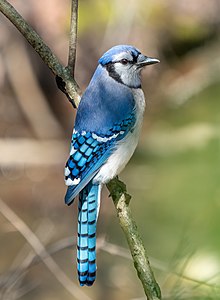
Back Blougaai Afrikaans قيق أزرق Arabic قيق ازرق ARZ Cyanocitta cristata AST Adi mavi zığ-zığ Azerbaijani Блакітная сойка Byelorussian Блакітная сойка BE-X-OLD Cyanocitta cristata Bulgarian ব্লু জে Bengali/Bangla Kegin c'hlas Breton
| Blue jay Temporal range: Piacenzian - present
| |
|---|---|

| |
| In Prospect Park, Brooklyn, New York | |
| Scientific classification | |
| Domain: | Eukaryota |
| Kingdom: | Animalia |
| Phylum: | Chordata |
| Class: | Aves |
| Order: | Passeriformes |
| Family: | Corvidae |
| Genus: | Cyanocitta |
| Species: | C. cristata
|
| Binomial name | |
| Cyanocitta cristata | |
| Subspecies | |
|
4 sspp., see text | |

| |
| Approximate distribution map
Year-round
Nonbreeding
| |
| Synonyms | |
|
Corvus cristatus Linnaeus, 1758 | |
The blue jay (Cyanocitta cristata) is a passerine bird in the family Corvidae, native to eastern North America. It lives in most of the eastern and central United States; some eastern populations may be migratory. Resident populations are also in Newfoundland, Canada; breeding populations are found across southern Canada. It breeds in both deciduous and coniferous forests, and is common in residential areas. Its coloration is predominantly blue, with a white chest and underparts, and a blue crest; it has a black, U-shaped collar around its neck and a black border behind the crest. Males and females are similar in size and plumage, and plumage does not vary throughout the year. Four subspecies have been recognized.
The blue jay feeds mainly on seeds and nuts, such as acorns, which it may hide to eat later;[2] soft fruits; arthropods; and occasionally small vertebrates. It typically gleans food from trees, shrubs, and the ground, and sometimes hawks insects from the air. Blue jays can be very aggressive to other birds; they sometimes raid nests and have even been found to have decapitated other birds.[3]
It builds an open cup nest in the branches of a tree; both sexes participate. The clutch may be two to seven eggs, which are blueish or light brown with darker brown spots. Young are altricial, and are brooded by the female for 8–12 days after hatching. They may stay with their parents for one to two months.
The name jay derives from the bird's noisy, garrulous nature and has been applied to other birds of the same family, which are also mostly gregarious.[4] Jays are also called jaybirds.[5]
- ^ BirdLife International (2016). "Cyanocitta cristata". IUCN Red List of Threatened Species. 2016: e.T22705611A94027257. doi:10.2305/IUCN.UK.2016-3.RLTS.T22705611A94027257.en. Retrieved 25 June 2022.
- ^ "The blue jays are coming! Hide yo kids, hide yo nuts!". Seriously, Science?.
- ^ Little Known Fact: Blue Jays are Vicious Carnivores. pedaldrivenprogramming.com (15 Apr 2008)
- ^ Coues, Elliot (1890). Key to North American birds (5th ed.). Boston, MA: Estes and Lauriat. p. 326. OCLC 469020022.
- ^ "jaybird – definition of jaybird by the Free Online Dictionary, Thesaurus and Encyclopedia". Retrieved April 20, 2011.
© MMXXIII Rich X Search. We shall prevail. All rights reserved. Rich X Search
